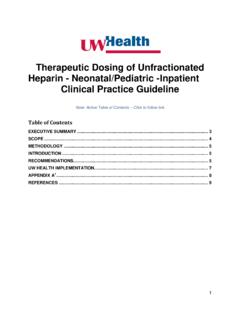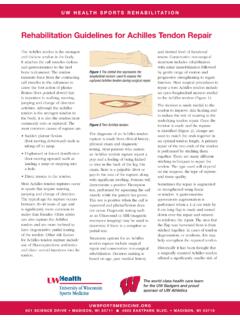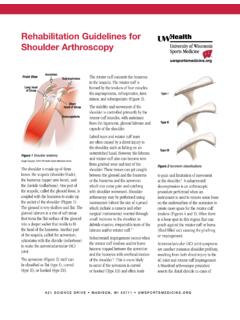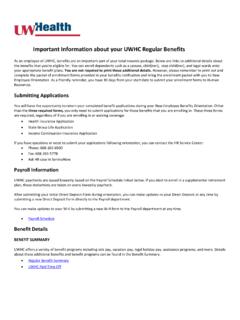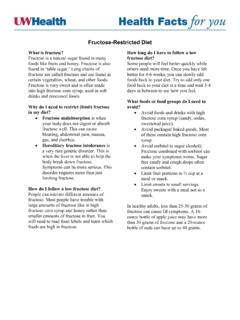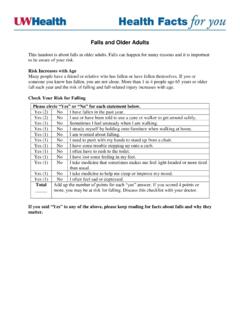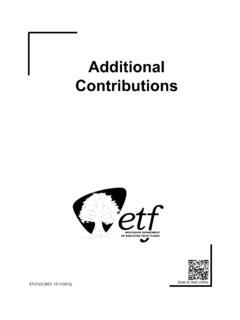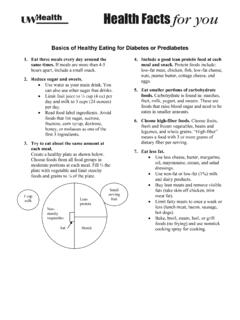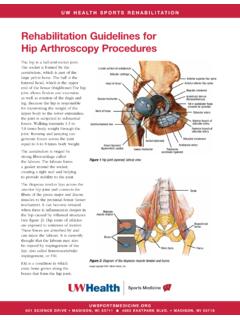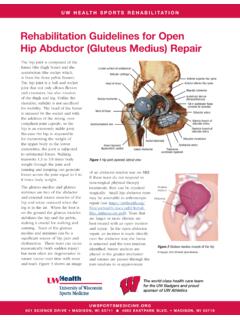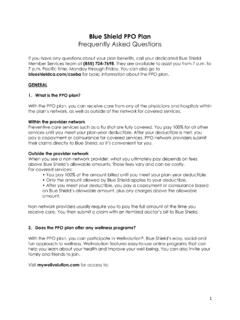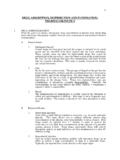Transcription of Rehabilitation Guidelines Following Total Ankle …
1 U W H E A LT H O R T H O P E D I C S A N D R E H A B I L I T A T I O N. Rehabilitation Guidelines Following Total Ankle Arthroplasty Rehabilitation is vital to regaining motion, strength and Driving function of the Ankle after surgery. These Rehabilitation If the operation is on the right foot, the patient may return Guidelines are presented in a criterion based progression. to driving when they can safely demonstrate an emergency General time frames are given for reference to the average, stop to someone else. To ensure legality, the patient should but patients will progress at different rates depending on contact their local insurer. their age, comorbidities, pre-surgical range of motion, strength, health/functional status, Rehabilitation compliance, Return to Work learning barriers and complications.
2 Specific time frames, restrictions and precautions are given to protect healing Return to work at four months is standard, however the tissues and the surgical reconstruction. Attention is Following should be taken into consideration: given to other musculoskeletal issues in areas above the Type of work replaced joint that can influence the outcome of the Total Surgeon's approval Ankle arthroplasty (TAA). The goal of this procedure is to Post-operative complications restore daily function and allow return to an active, healthy lifestyle. No patient with a Total Ankle replacement should be doing work that causes impact to the joint. Basic Expectations Following Surgery Pain and Swelling This is a procedure that can be painful during the recovery period and given the extensive nature of the surgery, can cause swelling.
3 It is normal for the foot and Ankle to be swollen 6 12 months post-operatively. Redness does not necessarily indicate infection. Significant drainage from the wound is usually a sign of infection. Rehabilitation Guidelines Following Total Ankle Arthroplasty PHASE I (surgery to 6 weeks after surgery). Appointments R ehabilitation appointments begin approximately 14 days after surgery, 1 2 times per week Rehabilitation Goals Activities of daily living (ADLs) with safe crutch/walker use; instruction as needed Control swelling and pain Begin Ankle range of motion (ROM) at 2 weeks (dorsiflexion (DF)/plantar flexion (PF). Maintain hip and knee ROM. Increase hip, knee and core strength Precautions N on-weight bearing (NWB).)
4 Short leg splint two weeks followed by CAM boot for one month or until week 6. Watch for signs of infection Avoid long periods of dependent positioning of the foot and complete frequent elevation Suggested therapeutic Frequent elevation of Ankle above the level of the heart Exercise/Treatment Ankle active range of motion (AROM [DF/PF]). Four-way leg raises lying down Knee AROM. Transverse abdominis recruitment Edema massage Cardiovascular Exercise Upper body ergometer (UBE). Progression Criteria 6 weeks post-op No wound complications 2 U W H E A LT H . O R G / J O I N T R E P L A C E M E N T. Rehabilitation Guidelines Following Total Ankle Arthroplasty PHASE II (begin after meeting Phase I criteria, usually 6 weeks after surgery).
5 Appointments Rehabilitation appointments are 1 2 times per week Rehabilitation Goals Reduce swelling Increase Ankle ROM in all planes Weight-bearing tolerance in boot with safe ADL progression in standing Increase mobility of scar Maintain hip/knee ROM, strength and flexibility Precautions Progress weight bearing as tolerated (WBAT) in boot per surgeon's instructions Suggested therapeutic Gait training and weight shifts Exercise/Treatment Ankle AROM/passive range of motion (PROM). Calf stretching Scar massage and soft tissue mobilization of calf Joint mobilization focus on talocrural distraction to improve Ankle DF/PF. Four-way Ankle isometrics Seated tilt/biomechanical Ankle platform system (BAPS) board Seated knee extension and prone hamstring curls against gravity (no Ankle weight Four-way leg raises in standing Transverse abdominis strengthening Cardiovascular Exercise Stationary bike (in boot, no resistance).)
6 Swimming (once wound is fully healed). Progression Criteria Able to ambulate independently in walking boot Active ROM between 5 DF and 20 PF. 3 U W H E A LT H . O R G / J O I N T R E P L A C E M E N T. Rehabilitation Guidelines Following Total Ankle Arthroplasty PHASE III (begin after meeting Phase II criteria, usually 10 weeks after surgery). Appointments Rehabilitation appointments are once per week Rehabilitation Goals WBAT in shoe Normalize gait without assistive device Retrain Ankle proprioception Improve Ankle strength Precautions Avoid exercises that create movement compensations Wean from boot and progress WBAT, with use of Ankle stabilizing orthosis (ASO). as needed Suggested therapeutic Gait training Exercise/Treatment Scar massage and joint mobilizations as needed Calf stretching Four-way Ankle strengthening with resistance band Balance and proprioception exercises Functional movements (squats, steps).
7 Core and lower extremity strengthening Cardiovascular Exercise Stationary bike Swimming Progression Criteria Able to ambulate independently in shoe Able to complete bilateral heel raises 4 U W H E A LT H . O R G / J O I N T R E P L A C E M E N T. RE-212917-18. Rehabilitation Guidelines Following Total Ankle Arthroplasty PHASE IV (begin after meeting Phase III criteria, usually 14 weeks after surgery). Appointments Rehabilitations appointments are once every 2-4 weeks Rehabilitation Goals Normal gait pattern Single leg stance with good control for >10 seconds Ankle ROM between 10 DF to 35 PF. Able to complete single leg heel raise Precautions Avoid forceful impact activities Anticipate return to golf at 3-4 months, hiking 4-5 months Suggested therapeutic Balance and proprioception exercises on unstable surfaces Exercise/Treatment Higher level core and lower extremity strengthening exercises Higher level functional movements (floor transfers, lunges, walking on hillsides).
8 Cardiovascular Exercise Stationary bike progressing to outdoor cycling Swimming Walking Golfing These Rehabilitation Guidelines were developed collaboratively between UW Health and UnityPoint-Meriter Rehabiliation and the UW Health Foot and Ankle Orthopedic Physician group. Updated 8/2018. References: 1. M. artin RL, Stewart GW, Conti SF. Posttraumatic Ankle Arthritis: An Update on Conservative and Surgical Management. J Orthop Sports Phys Ther. 2007 May;37(5):253-9. 2. S teck JK, Anderson JB. Total Ankle Arthroplasty: Indications and Avoiding Complications. Clin Podiatr Med Surg. 2009 Apr;26(2):303-24. At UW Health, patients may have advanced diagnostic and/or treatment options, or may receive educational materials that vary from this information.
9 Please be aware that this information is not intended to replace the care or advice given by your physician or health care provider. It is neither intended nor implied to be a substitute for professional advice. Call your health provider immediately if you think you may have a medical emergency. Always seek the advice of your physician or other qualified health provider prior to starting any new treatment or with any question you may have regarding a medical condition. Copyright 2018 UW Health Orthopedics and Rehabilitation 5 U W H E A LT H . O R G / J O I N T R E P L A C E M E N T.
